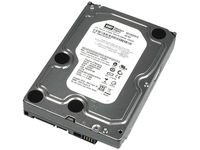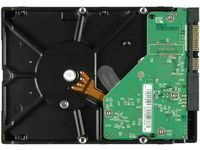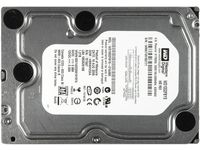Seagate's 1.5TB Barracuda: Bigger And Better?
Western Digital RE3, WD1002FBYS (1 TB)

We received a second hard drive at the time we were looking at the new Barracuda 7200.11 1.5 TB: Western Digital’s new RAID Edition 3 (RE3) drive. This model is based on the latest Caviar Black 1-TB drive, but has been optimized for server/workstation workloads and validated for 24/7 operation. As you might imagine, it also comes with a five-year warranty like most of the other entry-level enterprise hard drives. In this context it will be interesting to see reactions from Hitachi, Seagate and WD because Samsung has recently announced its intention to increase the warranty for enterprise drives from five to as much as seven years—not bad at all.
RE3
The product family of WD’s RAID Edition 3 is not much easier to decipher than Seagate’s Barracuda 7200.11. There are five models: 1000 GB, 750 GB, 500 GB, 320 GB and 250 GB. The 1 TB and 750 GB versions come with 32 MB of cache memory, while the others have 16 MB cache. This, however, doesn’t mean that these are the fastest drives, as the 320 GB and 250 GB models are specified to reach 118 MB/s throughput, while the larger capacity models are rated at 113 MB/s.
Great Performance
The 12.1 ms average access time is the best result of all 7,200 RPM drives that went through our test bed. I/O performance underscores this result, as the Western Digital RE3 drive provides best-in-class results in our file server, Web server, database, and workstation I/O benchmarks. We saw a maximum throughput of 110 MB/s, which is close enough to WD’s stated 113 MB/s maximum. Our Promise controller most likely is the reason for the missing 3 MB/s throughput, but since it has the same limitations with all other tested drives, the results are equally valid. The application performance in PCMark05 is also at an excellent level, mostly only beat by 10,000 RPM drives (Windows XP start-up performance) and by the drives that deliver higher throughput (file write test).
Top of Class Efficiency
Although the drive idle power requirement is neither revolutionary nor exceptionally low, it combines great I/O performance with acceptable power consumption. This results in an excellent result in our workstation I/O efficiency test; the RE3 drive reaches a good result in the streaming read efficiency test as well.
Get Tom's Hardware's best news and in-depth reviews, straight to your inbox.


Current page: Western Digital RE3, WD1002FBYS (1 TB)
Prev Page Seagate Barracuda 7200.11, ST31500341AS (1.5 GB) Next Page Comparison Table And Test Setup